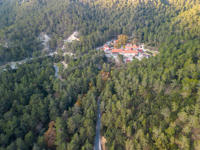Monastery of St John the Forerunner of Mesa Potamos
The Monastery of St John the Forerunner of Mesa Potamos, also known as Timiou Prodromou, is a fascinating historical site situated in the Troodos Forest of Cyprus. The monastery is dedicated to Timio Prodromo, and it is believed to have been built during the Byzantine period in the 12th century. The monastery's location is filled with greenery, including many pine trees and a small river.
The monastery's exact date of construction can be confirmed through various sources, including the writings of Archimandrite Epifaniou and an icon of the 12th century of the Zoodochou Pigi Saitiotissa. The monastery was one of many constructed in the area during the same period. However, the first written testimony of the monastery is dated to the 15th century, specifically a decree of the Frankish King Jacob B’ dated to the 4th of April 1468.
The monastery had a small chapel and only two or three rooms during the time of the Russian explorer Barsky's tour in the area. According to Barsky's account, the monastery was isolated from the world, and it was suitable for a life of solitude. The monks who lived in the monastery survived through agriculture and by raising goats. Despite its impressive location, Barsky was disappointed by the monastery's architecture.
Over the years, the monastery has had several uses. From 1914 until 1960, the monastery operated as a hotel. However, it was later abandoned and brought strong signs of wear and tear until 1998. The Metropolite of Limassol Chrysanthos made an attempt to restore the church in 1998, and his efforts were continued by the next Metropolite, Athanasios. Finally, the monastery was restored in 2003 under the guidance of the Metropolite of Limassol Athanaiou and the financial aid of Konstantinos Leventis. During the same year, the monastery was staffed with seven monks, and in 2005, it was manned by the Archimandrite Nikolao and seven monks.
In addition to being a historical site, the Monastery of St John the Forerunner of Mesa Potamos has played a significant role in Cyprus's political history. The monastery was a shelter for the EOKA fighters during the freedom fight. In particular, it accommodated the fighters of Troodos, and the British soldiers raided the monastery in an attempt to find the fighters' hideouts. Furthermore, the monastery was a meeting point for Makarios III and the general of EOKA, George Grivas, during 1950 until 1954. In 1949, the Archbishop Makarios stayed at the monastery for a few days to draw up documents for the Unifying Referendum.
The monastery's unique location and history make it a must-visit site for those interested in history and culture. The annulus that channeled the water from the monastery to the area of Saittas still exists and is part of the monastery. It is interesting to see how the water was used for the operation of a wooden windmill as well as provide electricity to the holiday houses. Today, visitors can explore the monastery's grounds and see the restored church and other buildings. They can also learn about the site's history and significance through guided tours or self-guided tours. The Monastery of St John the Forerunner of Mesa Potamos is a significant cultural and historical site that provides insight into Cyprus's past and present.
General Information
Ratings
Spectacular
1
Fantastic
0
Enjoyable
0
Average
0
Terrible
0
5.0

